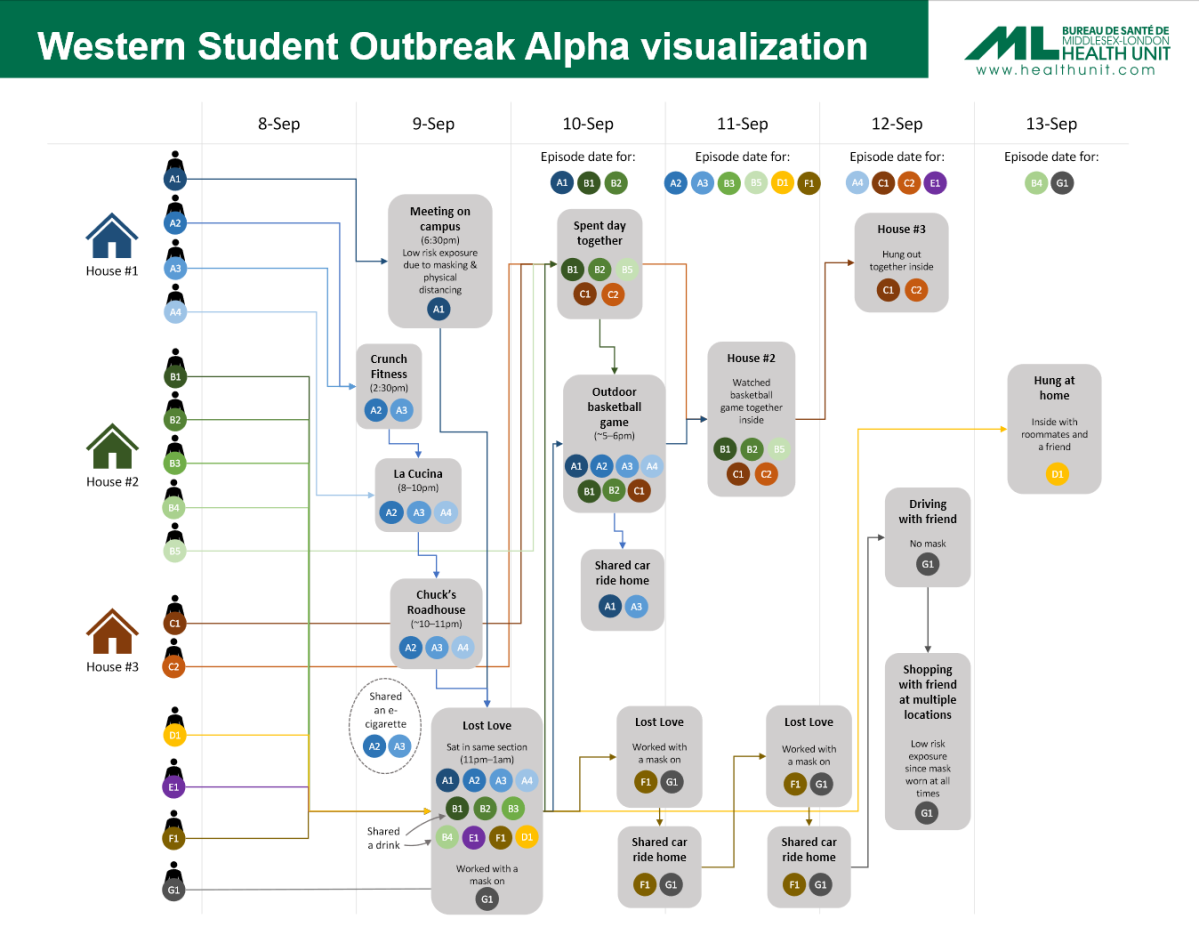Three households, one night at a club and a few other gatherings are responsible for the majority of the 28 novel coronavirus cases identified so far among Western University students, according to the Middlesex-London Health Unit (MLHU).

At a media briefing Thursday afternoon, medical officer of health Dr. Chris Mackie walked through the series of events between Sept. 8 and 13 that the health unit has pieced together to help explain how 15 of the cases occurred.
“The first cluster that we identified over the weekend that triggered the declaration of a community outbreak is the majority of those 28 cases,” he said.
“There are at least another seven associated with a single house party and a smattering of other individual cases linked with party or bar activity.”
In explaining a graphic showing the links between cases, Mackie said the chart includes only people who have tested positive as part of the main cluster, not all of the people who were present at the various gatherings. Click here to see the graphic in full.
“Of course, there are many other contacts at each of these situations where the risk was present and large numbers of people were gathering,” Mackie said.
Starting Sept. 9, members of all three households and a few additional people took part in a variety of “contributory activities” to the spread of the virus, including a meeting on campus, a workout, visits to restaurants and a gathering at a nightclub.
House 1 has four residents who’ve tested positive for the novel coronavirus.
At 2:30 p.m. on Sept. 9, two House 1 residents went to a Crunch Fitness location. They and an additional resident went to La Cucina restaurant from 8 to 10 p.m. that night and then Chuck’s Roadhouse bar and grill from 10 to 11 p.m.
Another resident of House 1 attended a meeting on campus at 6:30 p.m. that day, though that event was deemed “low risk” by the MLHU because of public health measures like masks and physical distancing.
All four of those residents went to Lost Love from 11 p.m. Sept. 9 to 1 a.m. Sept. 10.
Also at Lost Love, four residents of House 2 — including two who shared a drink — and three additional people, for a total of 11 people, sat in the same section. Two members of House 1 in the section also shared an e-cigarette at one point.
“Some of this contact is much more close than is necessary,” Mackie noted, “and exactly the sort of thing that we believe is bound to spread the COVID-19 virus.”
An additional person, a staff member, has also since tested positive for the novel coronavirus.
While they worked with a mask on, they later worked with someone who was in the same section as members of House 1 and House 2 and ended up sharing a car ride home on subsequent nights.
“It’s not exactly clear which of those contacts would have generated that individual’s infection, but it could be some or all of those contacts providing that person with enough exposure to the virus to become sick.”
House 3 is introduced on Sept. 10 after its two residents who’ve since tested positive spent the day with three of the five people in House 2 who’ve tested positive.
Two residents of House 2 and one House 3 resident also took part in an outdoor basketball game from 5 to 6 p.m. Sept. 10 with all the residents of House 1 who’ve tested positive.
On Sept. 11, the two who’ve tested positive from House 3 went over to House 2 to watch a basketball game inside with three of the five members of House 2.
- N.S. mom calls for better ultrasound access after private clinic reveals twins
- 3 women diagnosed with HIV after ‘vampire facials’ at unlicensed U.S. spa
- ‘Super lice’ are becoming more resistant to chemical shampoos. What to use instead
- Solar eclipse eye damage: More than 160 cases reported in Ontario, Quebec
“Again, there were additional individuals at that gathering that aren’t shown here because they haven’t ended up testing positive.”
The following day, on Sept. 12, the two members of House 3 who’ve tested positive spent the day inside together.
As well, the person who was working at Lost Love went driving with a friend without wearing a mask. They also went shopping with a friend at multiple locations, though that was deemed “low risk” because masks were worn at all times.
Finally, on Sept. 13, one of the additional people sitting in the same section as members of the three households on Sept. 9 ended up hanging out at home inside with roommates and a friend.
“These are the sorts of activities that we believe are responsible for this outbreak and also likely similar activities related to the other cluster that we have and the individual cases that have tested positive,” said Mackie.
“It’s gathering in large groups. It’s gathering in close contact with people from outside of your household or outside of your bubble. It’s unnecessary, very close contact, things like sharing food, drinks, e-cigarettes — all the sorts of things that we know are just the highest risk in terms of the spread of COVID-19.”

Mackie says he anticipates additional cases, noting that when you take into account the incubation period, even if every single person followed public health protocols as soon as the outbreak was declared, the health unit would still be seeing cases that haven’t yet been diagnosed.
However, he added that, “fortunately, we haven’t seen spillover from the outbreaks into the general population.”
“But if and when we do,” he said, “we won’t hesitate to take further actions in terms of public health enforcement or orders if necessary.”










Comments